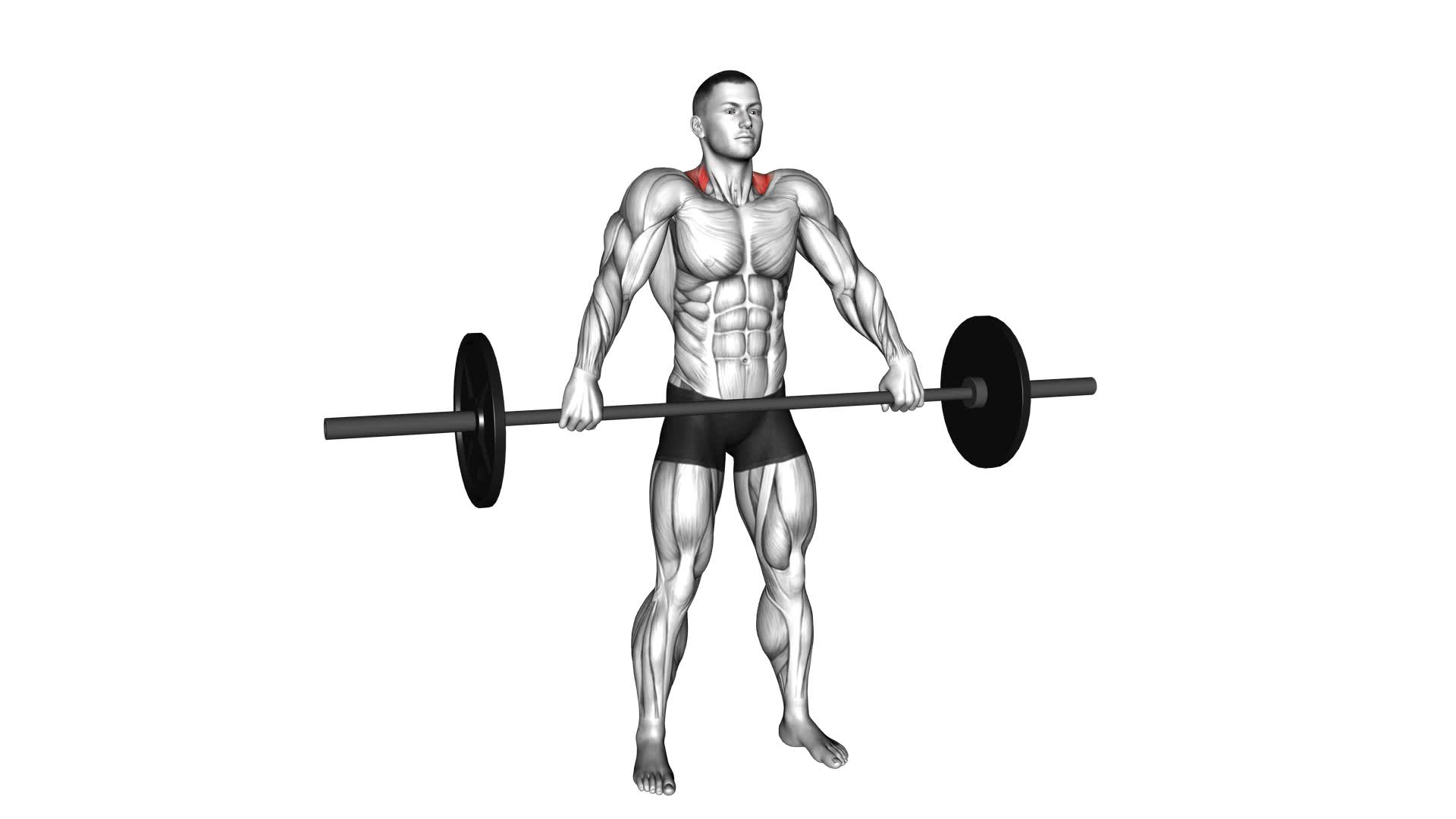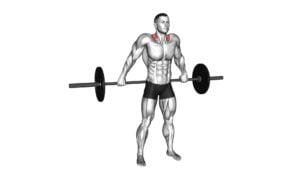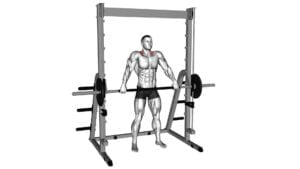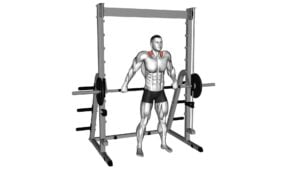Barbell Wide Shrug – Video Exercise Guide & Tips

Are you looking to strengthen your upper back and shoulders? The Barbell Wide Shrug is a fantastic exercise that targets those areas and helps improve your posture.
Watch This Exercise Video
In this video exercise guide, we'll show you the proper form and technique, as well as some variations to spice up your workout.
Avoid common mistakes and maximize your results with our helpful tips.
Get ready to sculpt and tone with the Barbell Wide Shrug!
Key Takeaways
- Barbell Wide Shrugs target and strengthen the upper back and shoulders.
- Proper shoulder positioning and engagement of upper back muscles are important for maintaining stability and improving posture.
- Common form mistakes to avoid include rounded shoulders, using momentum, and excessive shrugging.
- To maximize results, focus on form and technique, be consistent with training, prioritize recovery, and incorporate resistance training and cardio.
Benefits of the Barbell Wide Shrug
To maximize the effectiveness of your workouts, you can target your trapezius muscles from a wider range of angles by incorporating the barbell wide shrug into your routine. This exercise provides numerous benefits for your shoulder health and muscle activation.
The trapezius muscles play a crucial role in stabilizing and moving the shoulder blades, and by strengthening them, you can improve your overall shoulder function and prevent injuries. The barbell wide shrug specifically targets the lower and middle fibers of the trapezius muscles, which are often neglected in other exercises. By performing this movement, you can effectively activate and strengthen these muscles, leading to better posture and shoulder stability.
Additionally, the barbell wide shrug allows you to lift heavier weights compared to other shrug variations, which can further enhance muscle activation and growth. This exercise also engages other muscles in the upper back, such as the rhomboids and the rear deltoids, providing a comprehensive workout for your upper body.
In the next section, we'll discuss the equipment needed for the barbell wide shrug, including the type of barbell and weights that are suitable for this exercise.
Equipment Needed for the Exercise
To perform the barbell wide shrug exercise, you'll need specific equipment. This exercise requires a barbell, which is a long metal bar with weights attached to each end. The barbell should be loaded with an appropriate amount of weight based on your fitness level and strength. It's important to ensure that the weights are securely fastened to the bar to prevent any accidents or injuries during the exercise.
In addition to the barbell, you'll also need a weightlifting belt for added support and stability. This belt is worn around the waist and helps to protect the lower back during heavy lifting. It's especially important when performing exercises like the barbell wide shrug, which involve lifting a significant amount of weight.
To properly execute the barbell wide shrug exercise, you should also have a firm grip on the barbell. This can be achieved by using weightlifting straps or chalk, which provide better grip and prevent the bar from slipping out of your hands.
Proper Form and Technique
To perform the barbell wide shrug with proper form and technique, it's important to focus on shoulder positioning. Keep your shoulders back and down, avoiding any shrugging or hunching. This will help engage your upper back muscles and prevent unnecessary strain on your neck and shoulders.
Be mindful of common form mistakes, such as using too much weight and compromising your form or lifting the barbell too high, which can lead to improper muscle activation.
Shoulder Positioning Importance
Ensure proper shoulder positioning by maintaining a stable and engaged posture throughout the Barbell Wide Shrug exercise. Shoulder mobility and muscle activation are crucial in achieving optimal results while avoiding injury.
To maintain proper shoulder positioning, start by standing with your feet shoulder-width apart and your knees slightly bent. Keep your chest lifted and your shoulder blades pulled back and down.
As you perform the exercise, focus on keeping your shoulders relaxed and away from your ears. Avoid shrugging or hunching your shoulders forward.
Engaging Upper Back Muscles
Engage your upper back muscles by maintaining a stable and engaged posture throughout the Barbell Wide Shrug exercise. This exercise is an effective way to target and strengthen your back muscles.
As you perform the exercise, focus on keeping your shoulder blades pulled back and down, and your chest lifted. This will help activate and engage the muscles in your upper back, including the trapezius and rhomboids.
By maintaining proper form and technique, you can maximize the benefits of the exercise and avoid unnecessary strain on other muscles. Engaging your upper back muscles during the Barbell Wide Shrug won't only help you build strength, but also improve your posture and overall upper body stability.
Now, let's move on to some common form mistakes to avoid during this exercise.
Common Form Mistakes
Maintain a stable and engaged posture throughout the Barbell Wide Shrug exercise to avoid common form mistakes and ensure proper form and technique.
Here are some common mistakes to watch out for:
- Rounded Shoulders: Avoid hunching your shoulders forward as this can lead to poor shoulder stability and reduce muscle activation.
- Excessive Momentum: Avoid using momentum to lift the barbell. Instead, focus on controlled and deliberate movements to fully engage the targeted muscles.
- Shrugging Too High: While it may be tempting to lift the barbell as high as possible, avoid shrugging your shoulders excessively. This can put unnecessary strain on your neck and compromise proper form.
Variations to Spice Up Your Workout
Looking to add some variety to your workout? Try these exciting variations to spice up your routine.
Incorporating variations into your workouts not only keeps things interesting but also helps to challenge your muscles in new ways and prevent plateaus.
One way to increase the intensity of your workout is by adding resistance bands or weights to your exercises. For example, you can attach resistance bands to your barbell during wide shrugs to provide additional resistance and engage your muscles even more.
Another variation you can try is the dumbbell wide shrug. Instead of using a barbell, hold a dumbbell in each hand and perform the shrug motion. This variation allows for a greater range of motion and targets your muscles from a different angle.
Lastly, you can experiment with tempo variations. Instead of performing the wide shrugs at a regular pace, try slowing down the eccentric (lowering) phase of the movement or pausing at the top of the shrug for a few seconds. These tempo variations can help to further challenge your muscles and increase the overall intensity of your workout.
Now that you know some exciting variations to try, let's move on to the next section and discuss common mistakes to avoid.
Common Mistakes to Avoid
To ensure proper form and maximize the effectiveness of your barbell wide shrugs, it's important to be aware of common mistakes to avoid. By avoiding these mistakes, you can reduce the risk of injuries and achieve better results.
Here are some common mistakes to watch out for:
- Using too much weight: It can be tempting to load up the barbell with heavy weights, but using too much weight can compromise your form and increase the risk of injuries. Start with a weight that allows you to maintain proper form throughout the exercise.
- Slouching or rounding your shoulders: When performing barbell wide shrugs, it's important to keep your shoulders back and down, avoiding any slouching or rounding. This helps to engage the targeted muscles effectively and prevents unnecessary strain on your neck and upper back.
- Holding your breath: Proper breathing techniques are crucial during any exercise. Avoid holding your breath while performing barbell wide shrugs. Inhale deeply before lifting the barbell and exhale as you lift the weight. This helps to stabilize your core and maintain proper form.
Tips for Maximizing Your Results
To maximize your results with the barbell wide shrug, it's crucial to focus on your form and technique. Make sure you're engaging the correct muscles and maintaining proper posture throughout the exercise.
Additionally, consistency is key – aim to perform the barbell wide shrug regularly and gradually increase the weight to challenge your muscles and see progress over time.
Form and Technique
For optimal results, focus on maintaining proper form and technique throughout the Barbell Wide Shrug exercise. This will ensure that you engage the targeted muscles effectively and minimize the risk of injury.
Here are some tips to help you maximize your results:
- Maintain shoulder stability: Keep your shoulders pulled back and down throughout the entire movement. This will activate the muscles in your upper back and prevent your shoulders from rolling forward.
- Activate the target muscles: Squeeze your shoulder blades together at the top of the shrug to fully engage your traps and upper back muscles. Focus on lifting the barbell with your upper back, rather than using your arms or shoulders.
- Control the movement: Avoid using momentum or swinging the barbell. Lift the weight in a slow and controlled manner, emphasizing the contraction of your upper back muscles.
Consistency Is Key
Stay consistent with your training to maximize your results. Consistency is key when it comes to building muscle and maintaining progress. It's important to stick to a regular workout routine and not skip sessions.
By consistently challenging your muscles through regular training, you allow them to adapt and grow stronger over time. Aim for a balanced approach that incorporates both resistance training and cardiovascular exercise.
Make sure to prioritize recovery as well, as it's during rest periods that your muscles repair and grow. Consistency also applies to your nutrition and lifestyle habits. Fuel your body with a balanced diet and make sure to get enough sleep.
Frequently Asked Questions
How Many Sets and Reps Should I Do When Performing the Barbell Wide Shrug?
When performing the barbell wide shrug, it's important to consider the number of sets and reps. To determine this, you should take into account your fitness level and goals.
Generally, for muscle growth and strength, aim for 3-4 sets of 8-12 reps. However, you can also vary the sets and reps to challenge your muscles in different ways.
Remember to listen to your body and adjust accordingly.
Is the Barbell Wide Shrug Suitable for Beginners?
The barbell wide shrug can be suitable for beginners if done with proper form and technique.
It's important to start with a lighter weight and focus on keeping your back straight and shoulders relaxed. Avoid rounding your back or shrugging your shoulders up too high.
Start with a few sets of 10-12 reps and gradually increase the weight as you get stronger. Remember to listen to your body and stop if you feel any pain or discomfort.
Can I Use Dumbbells Instead of a Barbell for the Exercise?
Yes, you can definitely use dumbbells instead of a barbell for the wide shrug exercise. This allows for a greater range of motion and targets the muscles in your upper back and shoulders.
However, using a barbell has its own benefits, such as increased stability and the ability to lift heavier weights.
Ultimately, it depends on your preference and fitness goals.
Can the Barbell Wide Shrug Help Improve My Posture?
The barbell wide shrug is a great exercise for improving your posture. By incorporating this exercise into your workout routine, you can strengthen the muscles in your upper back and shoulders, which can help improve your overall posture.
To perform the barbell wide shrug correctly, make sure to keep your back straight, engage your core, and lift the barbell using a wide grip. Remember to start with lighter weights and gradually increase the load as you get more comfortable with the exercise.
Are There Any Specific Muscles Targeted by the Barbell Wide Shrug Exercise?
When you do the barbell wide shrug exercise, several specific muscles in your upper body are targeted. These include the trapezius, rhomboids, and deltoids. By engaging these muscles, you can strengthen and tone your back, shoulders, and neck.
This exercise is great for improving posture and enhancing overall upper body strength. Make sure to maintain proper form and use a weight that challenges you without sacrificing your technique.
Conclusion
In conclusion, the barbell wide shrug is an effective exercise for targeting and strengthening the upper back and shoulder muscles. It can help improve posture, increase shoulder stability, and enhance overall upper body strength.
By following proper form and technique, incorporating variations, and avoiding common mistakes, you can maximize your results and get the most out of this exercise.
So grab a barbell and start incorporating the barbell wide shrug into your workout routine for a stronger and more sculpted upper body.

Author
Years ago, the spark of my life’s passion ignited in my mind the moment I stepped into the local gym for the first time. The inaugural bead of perspiration, the initial endeavor, the very first surge of endorphins, and a sense of pride that washed over me post-workout marked the beginning of my deep-seated interest in strength sports, fitness, and sports nutrition. This very curiosity blossomed rapidly into a profound fascination, propelling me to earn a Master’s degree in Physical Education from the Academy of Physical Education in Krakow, followed by a Sports Manager diploma from the Jagiellonian University. My journey of growth led me to gain more specialized qualifications, such as being a certified personal trainer with a focus on sports dietetics, a lifeguard, and an instructor for wellness and corrective gymnastics. Theoretical knowledge paired seamlessly with practical experience, reinforcing my belief that the transformation of individuals under my guidance was also a reflection of my personal growth. This belief holds true even today. Each day, I strive to push the boundaries and explore new realms. These realms gently elevate me to greater heights. The unique combination of passion for my field and the continuous quest for growth fuels my drive to break new ground.



